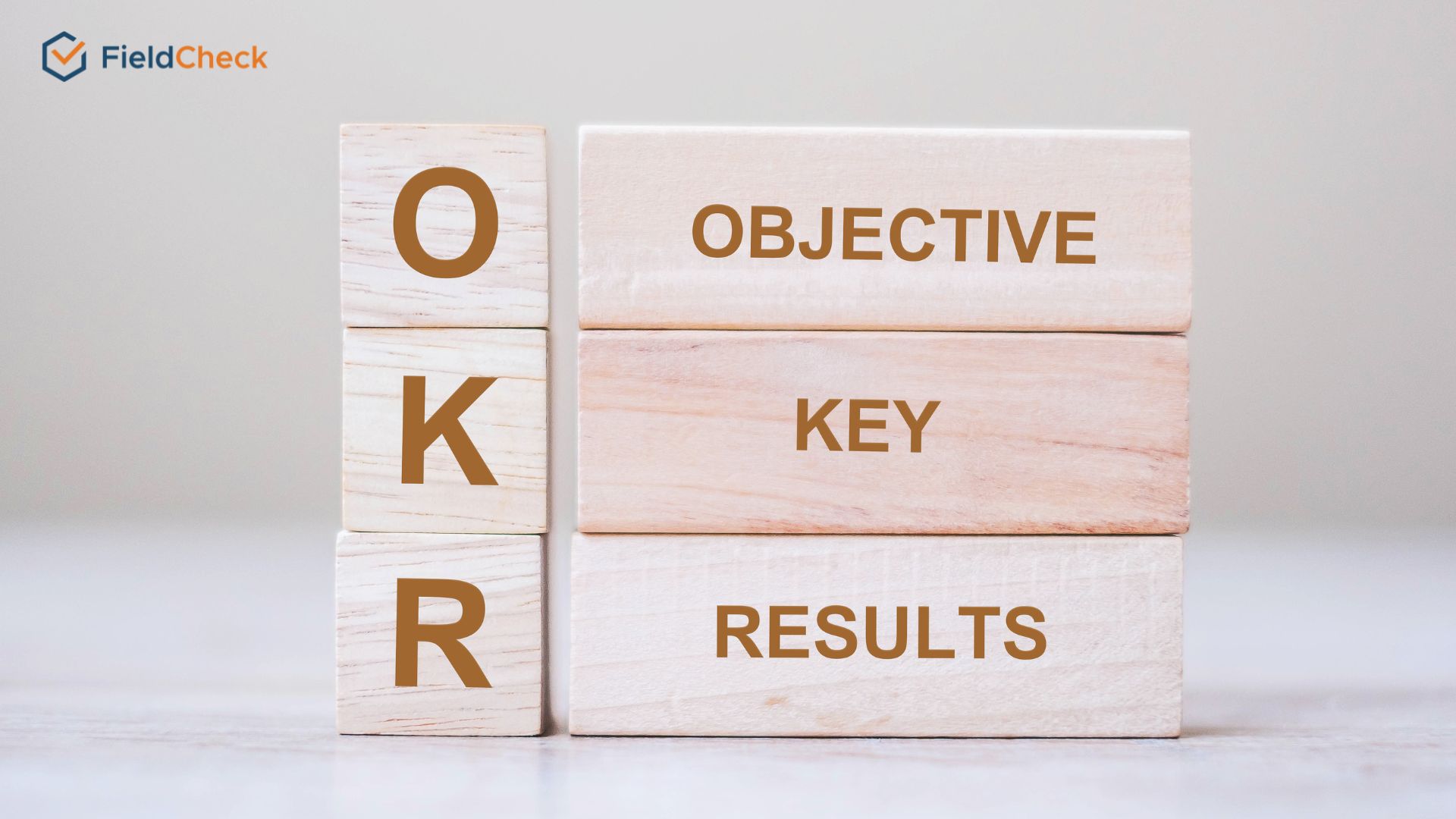What is OKR? Top Management Method of Tech Giants
In addition to the KPI capacity assessment method, many businesses are gradually turning to the OKR model. So what is OKR? Why is this method favored by many big names?
Let's find out with FieldCheck in today's article!

OKR is a model to manage quality
What is OKR?
What is OKR? The OKR management method is a way to help create a connection event within the company and organization by connecting the goals of the business, the department with the goals of individuals, together towards specific end results. .
There are two main features in the OKR method: structure and working principle. To be able to dig deeper into these two characteristics, let's learn the following content.
OKR Structure and Working Principle
1. Structure
The OKR methodology builds on two questions:
- Objectives: these are company, departmental and individual goals.
- Key Results: measures to help achieve goals. The system helps maintain the high-level apparatus in businesses and organizations with individuals, helps create links between target layers that can affect each other, and together direct everyone to focus on a specific path.
2. Working principle
The difference of the OKR method is that it is based on the following goal management system:
- Measurable
- Ambition
- Calculate performance
- Transparency
This method originated from Andy Grove of Intel Group and was inherited and developed by John at Google. Currently, the OKR management method is applied in many different organizations such as the US Navy and Spotify.

OKR methodology helps to align corporate and management ambitions with reality
Why OKR Is A Perfect Alternative To KPIs?
So you have known the answer to the question, what is OKR?. It's time to swtich to know its importance compared to KPIs. If businesses use KPIs and want to convert to OKRs, businesses will often evaluate KPIs as goals. The full transition between the two models will take time.
The OKR methodology helps to align corporate and management ambitions with reality. By switching to OKRs, management will be able to change performance reviews and create goals within the team without disrupting day-to-day tasks.
Besides, when starting OKRs, there will be many problems that businesses will not face like before. Long-term goals help management and employees know what needs and should be done (results) and causes (goals), avoiding deviations.
By using OKRs, managers can also expand their teams without disrupting work or productivity. In addition, businesses also use a combination of OKR vs KPI to effectively manage organizational resources.

The management will be able to change performance reviews
Benefits of the OKR Method
This method helps to support corporate governance thanks to six main advantages as follows:
- Improve transparency: The OKR method helps to build a culture of transparency in the organization and the business. Therefore, both employees and management can have a good grasp of departmental and individual plans and work.
- Close business linkage: The OKR method helps to connect the performance and work performance of employees in the enterprise, towards the ultimate goal. Accordingly, the management level will ensure that everyone is going in the same direction.
- Empowering employees: Thanks to a clear understanding of the operational situation at the business and organization, management will be able to make better decisions. Besides, the method can also create initiative for employees to perform and monitor their work.
- Focus on the essentials: OKRs can set 3-5 goals for the business, helping both employees and management prioritize important goals.
- Capture progress towards goals: Thanks to the indicators established in the method, the management team will have an overview of the work progress. When any unexpected problems happen, they can also handle it promptly and quickly.
- For outstanding results: The OKR method helps management to bring into full play their abilities in their tasks, helping businesses achieve impressive results.

OKR model supports corporate governance
Steps to Build an Effective OKR Strategy
In the process of setting up and planning an OKR method after knowing what is OKR, there are a few points you will need to pay attention to as follows.
For Objectives:
- Need to set clear goals, as detailed as possible. For example, in 2022, enterprises will conduct business expansion to China instead of just expanding overseas business markets.
- There should be 3-5 goals for each level
- Often, goals are set beyond ability, creating a feeling of difficulty and challenge. For example, Google says achieving about 70% of the goal can be considered success. If it's 100% done, it's perfect.
For Key Results:
Businesses will need to focus on three key outcomes for each of the different goals. The results must sum up the small steps to perform. Therefore, it is better to achieve the key results than to achieve the goals.
Efficiency can be measured. OKR examples include expanding 10 stores instead of just saying expanding more stores. Outcomes should be more descriptive of the output than merely actionable.

OKR method in use
A Detailed Guide To Setting Up the OKR Method
Here are specific guidelines to help you build a plan for the OKR method.
1. Define Objectives and Outcomes
The management level when building OKRs needs to state 3 to 5 key goals of the business and the company in the next quarter or year. These goals can be derived from the vision and mission of the leadership in the business and the company.
However, they will need to flexibly go from specific metrics like “Increasing business metrics by 100%” to sustainable corporate values like “Using environmentally friendly energy for business.”

Building OKRs needs to state 3 to 5 key goals of the business
After setting goals, teams and departments within the company can determine the specific results that need to be achieved to achieve that goal.
For example, if the Sales department needs to increase sales results by 100%, it should set the result to hire 3 sales staff. Establishing effective results will guide the next level of goals for the business and the organization.
2. Setting up the OKR
Different businesses of different sizes will likely have different ways of tracking OKRs. Businesses like Google have been able to build their own in-house toolkits while others use other familiar solutions like Microsoft Excel.
Besides, there are other specialized software to help track OKR metrics such as FieldCheck, Base Goal, Lattice, etc. Whatever software you choose, you should carefully prepare the specific process before implementing the OKR.
Because without doing so, the work will be messy and the company cannot optimize the value that the OKR method brings.

There are other specialized software to help track OKR metrics
3. Disseminate Method With Team Leaders, Departments
What you need to do next is to schedule a meeting with management to disseminate the established plan for the OKR method. This meeting will need to pay attention to the following points:
- Overview of OKR
- Why use OKRs instead of KPIs?
- How to use OKRs in the task. Advantages and disadvantages of OKRs.
- Discuss OKRs.
After completing these steps, the department head will be able to capture the OKRs of the business and the company. Accordingly, it is possible to plan for the Goals and Outcomes of each of your teams.

OKR is crucial for businesses
4. Disseminate OKR Method to All Employees in the Enterprise
After the meeting with the department head, you will need to spread the OKR to everyone in the company. Like in the previous step, you'll need to make sure the reason and importance of OKRs is for the company.
5. Manager Work With Everyone On Team To Set Personal Goals
After the OKR is disseminated to the whole company, management can make an appointment with each person on the team so that individual goals can be set.
This is considered a two-way meeting: What does management want everyone on the team to do and what does the employee expect to do?
At the end of the session, you will need to articulate the company's expectations to employees and vice versa. By organizing and maintaining such meetings, employees will feel empowered to make decisions about their work and career.

OKR is disseminated to the whole company
6. Presentation of OKR
After discussing with employees, management can discuss whether the employee's perspective affects the OKR of the department or the whole business.
After they can agree on OKRs for the quarter and year, it's time to present it in the discussion with the whole company and agree on the direction in the near future.

OKR introduction
7. Manage and Track Personal OKRs
During the quarterly and annual period, management should continuously monitor and check the progress of employee OKR implementation, aiming to ensure that the whole business is on track with the original plan.
The Story of Google OKRs
Right after its first year, Google adopted the goal-setting method they still use today. They build on the Objectives and Key Results framework that founders Larry Page and Sergey Brin first introduced in 1999 by venture capitalist John Doerr.
When John Doerr, one of the Google investors shared the Goals and Key Results framework with Larry, Sergey and the company's small team, he introduced the term OKR on his presentation slide, which is a management approach that helps ensure that a company focuses its efforts on the same important issues throughout the organization.
OKRs include key goals and results. Goals outline what you want to achieve. It's action-oriented, concrete, and inspirational. Key results tell you how you will achieve your goals and track your progress.
Google's leaders realized they needed an organizational principle, and because OKRs are data-driven and flexible, it's an attractive framework for a company that recognizes the importance of OKRs.

Google uses OKR method
In addition, the transparency provided by OKR is also a boon for Google, a company committed to an open web and open systems. Google is not only committed to applying OKR since its establishment, but until now, OKR has been applied continuously and effectively.
Google implements OKRs at three levels: individual, departmental, and corporate. Google does an annual OKR process to set big goals for the year that can still be modified based on what happens during the year, Google typically sets 4-6 OKRs per quarter.
Google encourages its team to set these quarterly goals as high as possible. One of the benefits of the OKR process is that everyone in the company is focused on the same goal.
At the end of each quarter, Google team members score their key results on a 0-1 scale. Google OKRs are suitable for everyone, from the top to the frontline. It's part of Google's internal records. Not only can anyone see each other's goals, but they can also see each other's scores.

Google OKRs are suitable for everyone
This may seem intimidating, but at Google, it helps people understand what other people are doing.
For example, when Rick Klau of Google Ventures is working on the YouTube homepage, his OKRs are visible to his team and everyone else in Google.
They can check his OKRs, see what he's up to and shape or model their own goals, and get guidance on how they can set up OKRs for the next quarter. Therefore, the main points in implementing OKR in Google can be summarized as follows:
- Key results are specific and measurable. Employees at Google can easily score their OKRs with a single number (Google uses a scale of 0 - 1.0 to rate each key result at the end of each quarter).
- A great score for OKR is 0.6 - 0.7 (60%-70% complete). If an employee consistently gets a 1.0 score, that OKR goal isn't challenging and ambitious enough.
- Low grades aren't a bad thing, and aren't tied to penalties or employee reviews. Instead, OKRs are used as data to help refine the next quarter's OKRs.
- OKRs are public and transparent. Everyone in the company can see what others are doing, their OKR scores, and other employees past and present.
How Uber Uses OKRs
Uber is a typical company in applying the OKR method to strategic goal management. Let's take a look at their "map" of development in 2016.
Example in goal I: Uber aims to have at least 20% driver coverage on Uber's system. Accordingly, the key results to be achieved are as follows:
- The frequency of driver appearance in each area is at least 25%
- The number of motorists increased by 5,000,000 worldwide.
- Increase the average driving time of drivers by 26 hours/week
Another example is Uber setting a customer satisfaction goal of 70%.

Uber example
Key results include:
- Conduct a 5-star rating on the driver (Based on customer reviews on attitude and cancellation rate). This information is presented transparently to customers.
- Reduce delivery time to less than 10 minutes.
Conclusion
Above is the information related to the question, what is OKR?. In short, compared with KPI, the OKR management method shows a number of outstanding advantages in terms of the ability to create linkages within the enterprise, accuracy and efficiency in performance evaluation.
RELATED POST:
- 7 Important Notes For An Effective KPI Strategy
- Top 5 Best KPI Management Software
- Kaizen Philosophy: The Application To Improve Business Productivity




